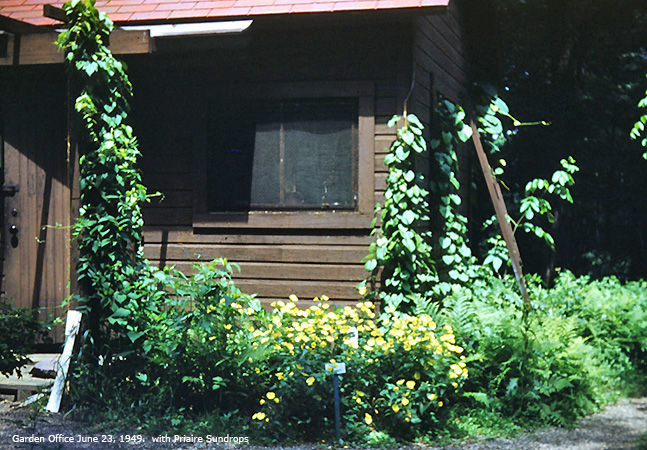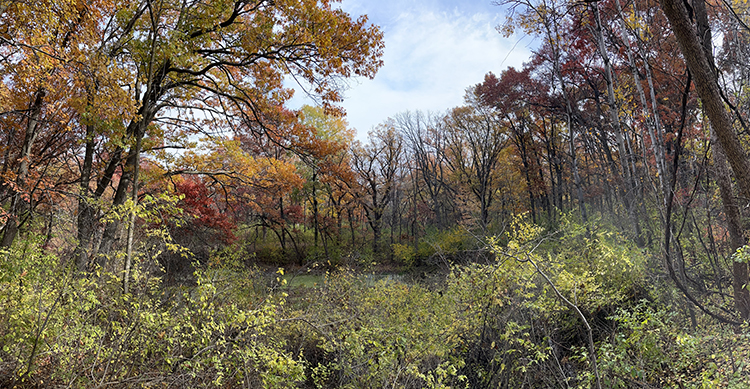Friends of the Wildflower Garden
A web of present and past events

These short articles are written to highlight connections of the plants, history and lore of the Eloise Butler Wildflower Garden with different time frames or outside connections. A web of intersections.
This month we meet the oldest known bird in the world and how we know that age. The Dutchman's Pipe-vine was in the Wildflower Garden for many years - a little history. Then we look at a newly re-discovered area in Wirth Park and winter activites with the Wildflower Garden Naturalists.
This Month
A re-discovered area in Wirth Park
New Winter Activities with Garden Naturalists.
100 Years of Bird Banding
Meet Wisdom
- the oldest known bird documented in the 90 year history of US and Canadian bird banding.

Wisdom, a Laysan albatross on Midway Atoll, photo John Klavitter, US Fish &Wildlife Service
She was first banded in 1956 with an estimated age of 5 years, the earliest age for sexual maturity in this species. On 4 December 2023 she returned to the nesting grounds on Midway Atoll - giving her an estimated age of 72 years.
Bird banding may go back as far as Roman times and it is reported in the Middle Ages, if only to mark a bird’s ownership.
We would know about bird ages were it not for the bird banding program, started in the United States by Paul Bartsch in 1902. The Bird Banding Laboratory at the US Geological survey has been keeping records since 1920. While banding and then retrieval can give the estimated age of a bird, it is the migratory pattern that has taught us much. It is these patterns and bird counts that tell us, for example, that the number Golden Winged Warblers has declined by 70% since 1960 in their prime habitat around the Great Lakes.

Golden-winged Warbler, photo Caleb Putnam CC-BY-SA 2.0
The most common groups of birds banded are the Near Passerines and the Passerines, with over 37 Million banding records since 1960, ducks are second. With all we know about where birds go in their migration patterns it may strike us as odd that even in the 1800’s people were perplexed about what happened to the birds - one day they were there and the next day they were gone - only to reappear months later.
There were many suppositions but the general confusion was clearly stated by British naturalist Gilbert White in his November 4, 1767 letter to fellow naturalist Thomas Pennant:
“As to the short-winged soft-billed birds, which come trooping in such numbers in the spring, I am at a loss even what to suspect about them. I watched them narrowly this year, and saw them abound till about Michaelmas, when they appeared no longer. Subsist they cannot openly among us, and yet elude the eyes of the inquisitive: and as to their hiding, no man pretends to have found any of them in a torpid state in the winter. But with regard to their migration, what difficulties attend that supposition! that such feeble bad fliers (who the summer long never flit but from hedge to hedge) should be able to traverse vast seas and continents in order to enjoy milder seasons amidst the regions of Africa!” (A Natural History of Selborne)
More on the history of bird migration: https://www.audubon.org/magazine/spring-2022/a-brief-history-how-scientists-have-learned-about
About the Bird Banding Lab: https://www.usgs.gov/labs/bird-banding-laboratory
The Dutchman's Pipe
It was a native plant reserve, but that did not deter either Eloise Butler or Martha Crone from experimenting with non-native plants in the early Eloise Butler Wildflower Garden.

One such plant is the Dutchman’s pipe-vine, Aristolochia macrophylla, which is native to the eastern United States, primarily in the Appalachians. Everywhere else it is an introduction.
The common name describes the flower calyx with its distinctive upward curved calyx and the 3-purplish petal lobes the spread outward giving the appearance of the old style Dutchman’s Pipe.
So, in 1910 Eloise Butler made a go-of-it. She obtained two plants for Jewell’s Nursery in Lake City Minnesota - a provider of both native plants and exotics. Into the Garden hillside they went - and survived. When her Garden Office was completed in 1915 and suitable trellis had been erected, they were moved to the office. They evidently survived quite well in the Garden.
Martha Crone noted the plant in her Garden Log with this comment on the last day of August 1939:
A blue-winged warbler flew up to the N.E. window while I closely observed it. It was hanging upside down on the leaves of the Dutchman’s pipe vine. It was a splendid opportunity to note it in detail being only a few inches from me.
In the photo below of the Garden Office from June 1949 you see the plants climbing the supports. Photo by Martha Crone. The yellow flowers in the center are Prarie Sundrops.

Martha planted several more of the species in 1954 and 1955, perhaps to replace the plants that did not recover from a rabbit attack in 1943 when the plants were eaten to the ground. Those may have survived until the old office was removed in 1969 to make way for the new Martha Crone Shelter.
The leaves are numerous and resemble those of the Carrion Flower Vine and the Wild Ginger but much larger. Pipe-vine is in the same plant family as the wild ginger - the Aristolochiaceae.
The leaves eaten by larvae of eastern Pipe-vine swallowtail butterfly, but not here in Minnesota - out of range for that butterfly.


A re-discovered area in Wirth Park
This past season the Friends Invasive Plant Action Group (FIPAG) began invasive clearing in a new area the northeast of the Wildflower Garden. Jim Proctor, co-chair of FIPAG writes:
“In our recent efforts just outside the Garden fence we’ve uncovered something really exciting—a small un-forested slope which sits above a small pond. This spot was obscured by a wall of non-native trees and shrubs including buckthorn, honeysuckle and Amur maple. Now that the invasive shrubs and trees are partly removed, we can see that it has great potential as a lovely meadow with a view of the pond below.”
Below: A view of the new area with pool where the FIPAG began work. Photo Jim Proctor.

“This is a nice counterpoint to the more densely wooded maple bowl (FIPAG previous project). The new area has an ephemeral pond, but quite open to the sky, surrounded by grassy meadow and open oak woods and savanna.
On Saturday 11-11-23 we finished weeding buckthorn sprouts in a swath along the top of this hillside and seeded it. We also weeded and seeded into the adjacent wooded area just to the north.
MPRB Natural Resources staff provided us a generous supply of buckthorn replacement seed mix from Minnesota Native Landscapes. It contains a mix of grasses, sedges and forbs to compete with any future invasives. Recent research shows this is very important. We’ve done modest seeding in the past, but we plan to make this a more significant part of our efforts going forward. Thanks MPRB!”
Below: Overlaid on the 1967 winter aerial photo of the Wildflower Garden area are the FIPAG work areas. The Maple Bowl outlined in yellow and the new area in red. Both areas show the small pool in the center of each. The white outline of the Garden has the upland fence in the approximate position of the 2022 expansion.

New Winter Activities with Garden Naturalists.
Friends President Jennifer Olson writes:
“Garden Naturalists are leading programming at Wirth Park this winter. This is a great collaboration between the Garden and the Loppet. Thanks to the Loppet for stepping up with funds to the MPRB to help finance this collaboration with the Garden naturalists.”
The Loppet stated: This collaboration has alread started and provides:
Join a Garden Naturalist for a Guided Walk: Tuesdays 10 - 11 a.m.
Winter Tracks & Wildlife - January 9, February 6 & March 5
Naturalists from the Eloise Butler Wildflower Garden will be offering weekly themed winter walks for all ages on a variety of topics including winter birding, winter tree ID, winter wildlife and tracks ID, and nature journaling.
Knitting Near Nature: Every other Wednesday 11:30 a.m. - 1 p.m.
January 10 - March 20
Bring your projects and join fellow crafters by the fire at The Trailhead.
Nature Storytime: Thursdays 10 - 10:30 a.m.
January 4 - March 28 *not offered on February 15
The Garden’s popular Nature Storytime program will be offered weekly for children with their caregivers with winter and nature themed stories and activities. This program takes place indoors in the Trailhead.
![Loppet [poster]](../../../generaljpegs/twigs_jpgs/2024loppetposter.jpg)
Registration is not required - just show up ready to have fun! On winter weekends starting in January, look for the Winter Nature Station staffed by a Wildflower Garden Naturalist in the Trailhead or out on the patio by the tubing hill! Stop by to learn all sorts of interesting things about the wonders of the natures in winter! We look forward to having a blast learning together this winter!
Go direct to the Garden webpage for any updates;
Photo Note
Photos that are credited with a "CC " caption are used under Creative Commons license for educational purposes. The letters and numbers, such as "CC-BY-SA 3.0" refer to the license type. These photos may be used by others only for free educational purposes so long as credit is given to the original author whose name precedes the license type. You may learn all about the requirements on the Creative Commons webpage.
Previous articles
December 2023 Curiosity About a Plant Name
December 2023 Are Honeycombs as Perfect as They Look?
December 2023 Why do Icicles Have Their Shape?
December 2023 Eloise's Issues with White Oaks
December 2023 Monarch Threatened with Fiery Death
November 2023 - The ESA at Fifty
November 2023 - Do Plants Hear?
November 2023 - Eloise Talks to Plants
November 2023 - The Rarer Rubus Compared
September 2023 - Friends Annual Meeting
September 2023 - The Wildflower Garden in October
September 2023 - Fall Gardening for Bees
September 2023 - The Wildflower Garden Perimeter Changes
All selections published in 2023